
Vernon Court, an adaptation of an early 18th century French château, was designed and built in 1898 for Mrs. Richard van Nest Gambrill of Peapack, New Jersey. Occupying one full block on Newport's historic Bellevue Avenue, Vernon Court was widely heralded as one of the most spectacular mansions of its kind in America. Author Barr Ferree wrote in American Estates and Gardens (1904) that Vernon Court was
"one of the truly greatest estates in America... It has startling beauty and daring originality giving it high rank among the notable houses of America."
It was compared with the White House, The Biltmore, The Breakers, and several others as one of the ten greatest mansions in America. Vernon Court stands today as an incredible architectural monument, and remains one of the most significant structures in the nation. The late J. Carter Brown, Director Emeritus of the National Gallery of Art in Washington, remarked in a 1999 letter to our founders, "Vernon Court has to be one of the very most beautiful in Newport, and its state of conservation should be a role model for everyone in the preservation field."
Vernon Court was designed by the noted architects John Merven Carrère and Thomas Hastings of Carrère & Hastings. Their other significant projects include the New York Public Library, US Senate & House Office Buildings in Washington, DC and many other nationally recognized architectural monuments. Perhaps the most significant of Carrère & Hastings' architectural designs is The Frick Collection, residence of industrialist and art collector Henry Clay Frick (1849-1919). It was designed so that the first floor could posthumously be converted into an art museum. Carrère & Hastings used Vernon Court as the antecedent design model for the remarkable Frick Collection. Interestingly, both Vernon Court and The Frick enter on the adjacent side streets rather than on Bellevue or Fifth Avenues, and also each have 100' wide white marble steps addressing the main Avenue.


Jules Allard et ses fils of Paris, the world's most noted interior designers at the turn of the 20th Century, were responsible for the interiors of Vernon Court. The Marble Hall, Petit Salon and Ballroom were all modeled after Marie Antoinette's private suites at the Palace of Versailles. Allard completed many other mansion interiors in Newport including The Elms, Rosecliff, The Breakers, and Marble House. The two loggias at opposite ends of the building were decorated with murals undertaken by Tiffany Studios' muralist, James Wall Finn, inspired by the Villa Giulia in Rome, home to Pope Julius III. The formal sunken gardens at Vernon Court were designed by the New York landscape architects, Wadley & Smythe, and were inspired by the Pond Garden at Hampton Court Palace created by King Henry VIII for his ill-fated Queen, Anne Boleyn.
At the adjacent estate, Stoneacre (the mansion was demolished in the 1962), the grounds were designed by the first American landscape architect, Frederick Law Olmsted in 1884. Vernon Court sits on three acres, with its Frederick Law Olmsted Park and Arboretum (Stoneacre) comprising another three acres. The Frederick Law Olmsted Park and Arboretum is truly the last proper open space on Bellevue Avenue, a grand promenade of the "Gilded Age" known today as the "most elegant street in America," set in Newport, "the Capitol of architectural beauty."


All of these architectural and landscape design treasures work together, and when combined with the most important paintings from the "Golden Age of American Illustration" make Vernon Court along with its adjacent grounds arguably one of our greatest national cultural treasures. Set in Newport within the timeless ambience of by-gone grandeur, Vernon Court is two blocks from Cornelius Vanderbilt II's The Breakers (1895), adjacent to Hon. George Wetmore's Chateau-Sur-Mer (1852), and adjacent to the William Watts Sherman house (1874) by H.H. Richardson, the first example of "Shingle Style," America's first indigenous architecture style.
Newport has an unparalleled architectural heritage; it is a virtual Museum of Architecture. These illustrious "Gilded Age" mansions are striking architectural monuments and are preserved forever, designated as parts Newport's National Historic District by the U.S. Department of the Interior. Vernon Court lies little more than an hour south of Boston, and is just over three hours from New York City.





